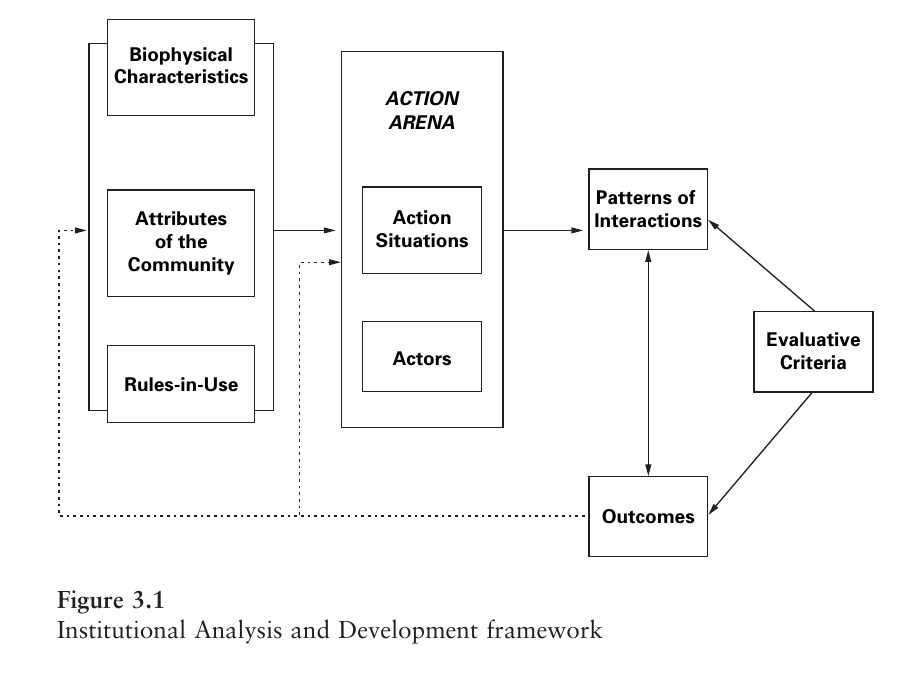This research note is based on Hess & Ostrom (2007). Not all aspects of their framework are directly relevant to our research, but it’s a very good start for an institutional analysis. Particular cultural and/or aesthetic aspects are not covered by their framework.
Hess and Ostrom are adapting the „Institutional Analysis and Development“ (IAD) framework, which they developed in for their studies of many commons centering around physical resources (forests, meadows, fisheries etc) for the analysis of knowledge commons.
This is their basic model of the different analytical dimensions for the study of a commons.

I. Resource characteristics
For the KC, they define
„Biophysical Chacteristics“
__ Facilities (pyhsical infrastructures)
__ Artifacts (files, data etc)
__ideas („coherent thoughts, mental images, creative visions, innovative information. Ideas are the intangible content and the non-physcial flows units contained in the artifacts.” (48))
“Attributes of the community”
__ Information users (who is using the resources)
__ Information providers (who is actively putting material into the resource)
__ Information managers (who manages and maintains the resource)
One person have have multiple nalytically different roles.
“Rules-in-use”
„Rules are shared normative understandings about what a participant in a position must, must not, or may do in a particular action situation, backed by at least a minimal sanctioning ability for noncompliance.“ (50).
__ Operational level (day-to-day decisions)
__ Collective choice level (rules about the operational level
__Constitutional level (rules that define who can contribute to the collective choice level)-> frequent move between levels in practice
__ Intellectual property rights as rules of „access, contribution, extraction, removal, management/participation, exclusion, alienation“
The second analytical column is called
II. Action Arena
“Action arenas consist of participants making decisions within a situation affected by the physical, community, and institutional characteristics that will then result in varying patterns of interactions and outcomes.” (53)
__ Action Situations (“The action situation focuses on how people cooperate or do not cooperate with each other in various circumstances. The analysis needs to identify the specific participants and the roles they play within the situation. It will look at what actions have been taken, can be taken, or will be taken and how these actions affect outcomes.”(53))
__ Actors (Questions: How much control has each participants? What kinds of information does each have about the situation? What are different incentives?)
All of this leads to
III. Patterns of interaction & Outcomes
Patterns of interactions are recurring ways interaction, they can be conflicting or negative.
Possible outcomes of the dynamics within KC (negative/positive)
__ Enclosure / access
__ Inequity / equity
__ Lack of standards (desintegration) / standards across repositories (integration)
__ Conflict and lack of cooperation / cooperation and reciprocity
__ Lack of quality control (pollution) / quality control and supporting mechanism (eg. documentation (richness)
__ Expansion intellectual property (enclosure) / open knowledg
__ Underuse / use (overuse in non-rival goods is rarely a problem)
__ Withdrawl of information / preservation and enhancement of access
Reference
Hess, Charlotte und Elinor Ostrom (2007): „A Framework for Analyzing the Knowledge Commons“, Understanding Knowledge as a Commons, Cambridge, MA: MIT Press, S. 41–71.
